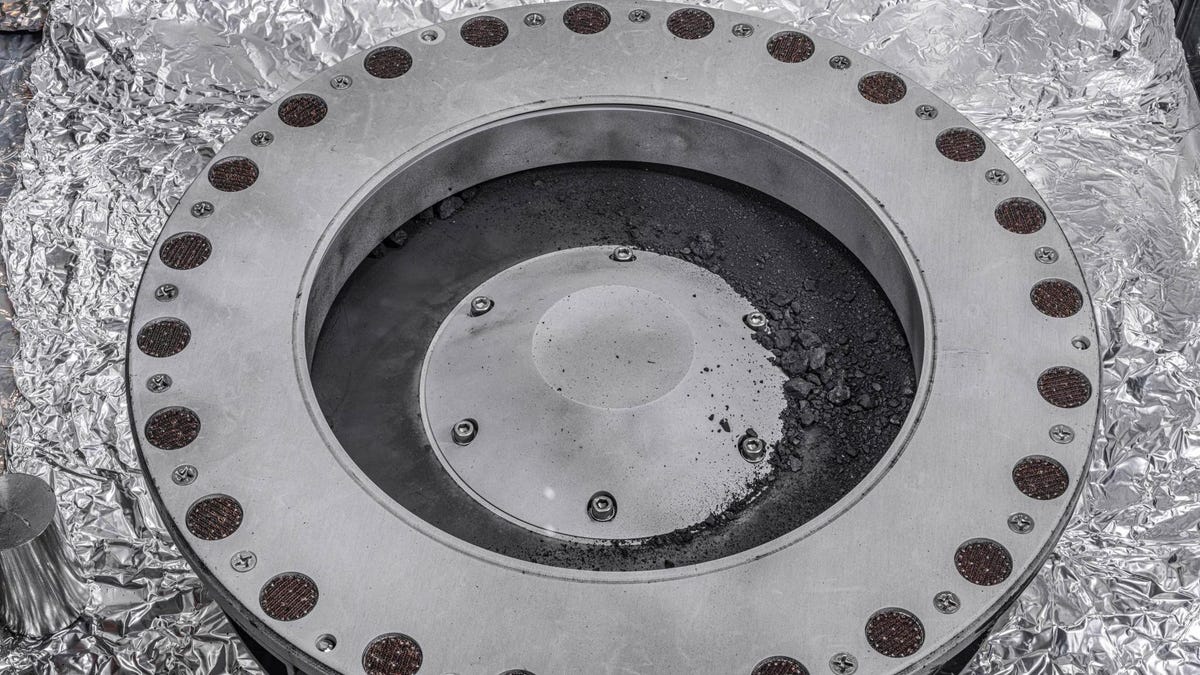The OSIRIS-REx container still contains most of the asteroid samples, but fragments of ancient space rock found outside have shown evidence of organic matter embedded within small pieces of debris.
On Wednesday, NASA released the first look In samples returned from asteroid Bennu by its OSIRIS-REx mission. Scientists performed initial analysis of the asteroid sample and found abundant carbon and water molecules, supporting the theory that the building blocks of life may have reached Earth via asteroids.
“This is the largest carbon-rich asteroid sample ever returned to Earth,” NASA Administrator Bill Nelson said during the event at the Johnson Space Center. In Houston. “Carbon and water molecules are exactly the types of material we want to find, important elements in the formation of our own planet and help determine the origin of the elements that led to life.”
There were samples It left Earth at the end of September, the OSIRIS-REx return capsule makes a parachute landing in the Utah desert after nearly three years in space. The curation team is carefully dissecting the TAGSAM (Touch-and-Go Sample Acquisition Mechanism) head to get the bulk of the sample.
Although they haven’t opened the sample bottle yet, Additional fragments of the asteroid were found outside of TAGSAM-A clear arm on the shuttle, with a circular sampling head at the end used for sampling. The entire sample exceeds NASA’s goal of collecting 60 grams from Bennu’s surface. What has been revealed so far from additional sampling is a mixture of fine dust and what we call some intermediate-sized particles,” said Nicole Luning, OSIRIS-REx’s chief observer, on Wednesday.
It will take a long time for the team to open the container to fully protect the remains of the asteroid outside. “The only problem is it’s a big problem, we’ve found more samples than we expected even before we got into TAGSAM,” Francis said. McCubbin, a NASA JSC curator on the show, said: “It’s going to take a while to go in because we have to collect every grain very meticulously and carefully, but the view so far is incredible.”
Over the past two weeks, the team has been analyzing some additional samples using electron microscopy, infrared and X-ray diffraction measurements, and chemical element analysis. The sample collected so far contains 4.7% carbon by weight, the highest carbon abundance ever measured. In an extraterrestrial model, step
Daniel Glavin, OSIRIS-REx S
Width up to
Researcher. It contains abundant water in the form of hydrated clay minerals.“We picked the perfect asteroid,” Clavin said. “Not only that, but we picked the right model: it’s an astronomer’s dream.”
Bennu is a small near-Earth asteroid that passes Earth every six years. Scientists believe that Bennu could have done this. It broke up from a very large, carbon-rich asteroid 700 to 2 billion years ago and came very close to Earth. Analyzing asteroid fragments in a laboratory can help scientists gather clues about the origin of the Solar System. Bennu is a dangerous near-Earth asteroid; Therefore, studying it closely can help us learn more about the possible threats to our planet.The OSIRIS-REx mission was launched in September 2016 and reached the asteroid Bennu in December 2018. After nearly two years of observations, the spacecraft Bennu et al He held a sample of its surface
In October 2020. On May 10, 2021, OSIRIS-REx bid farewell to Bennu and began its journey to drop its precious cargo.
Once the models landed on Earth, work on the ground began. The sample analysis team consists of 230 scientists from around the world, and fragments returned from the asteroid will be assigned to different teams to conduct in-depth analysis of Bennu’s composition. Hoping to take advantage of advanced technology in the coming years, NASA will hold at least 70% of the sample at the Johnson Space Center for future research for decades. Some asteroid fragments are available for public display at the Smithsonian Institution, the Houston Space Center, and the University of Arizona. Follow us for more space travel in your life X (formerly Twitter) and bookmark the dedicated Gizmodo page Space flight
This content is automatically translated from the original material. Due to the subtleties of machine translation, slight differences may occur. For the original version, Click here.


:quality(85)/cloudfront-us-east-1.images.arcpublishing.com/infobae/OLNQLJRERZDCRBK5TW2XPCFNTU.jpg)

:quality(85)/cloudfront-us-east-1.images.arcpublishing.com/infobae/VYMZLY2LCVF7JLLP2QY5TOANM4.jpg)
:quality(85)/cloudfront-us-east-1.images.arcpublishing.com/infobae/MKYXZKOXMFALPMPONCZCOUAWEE.jpg)